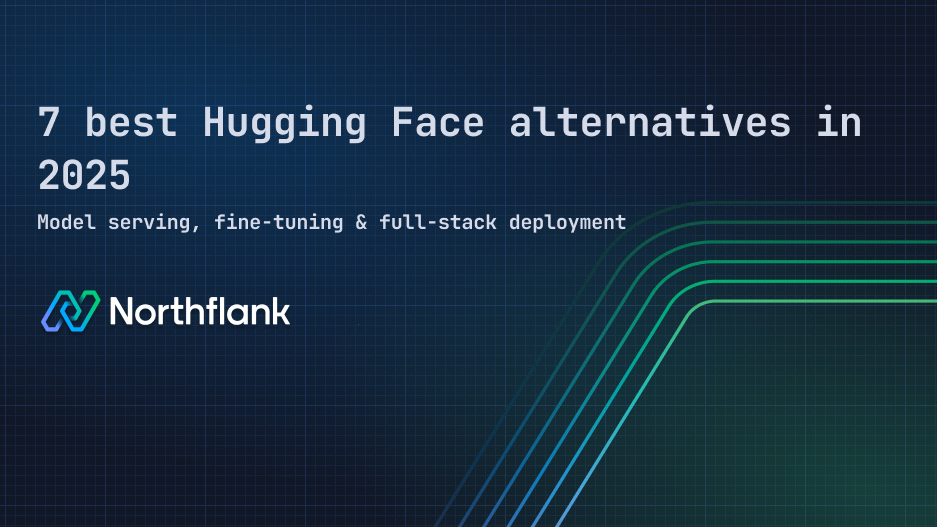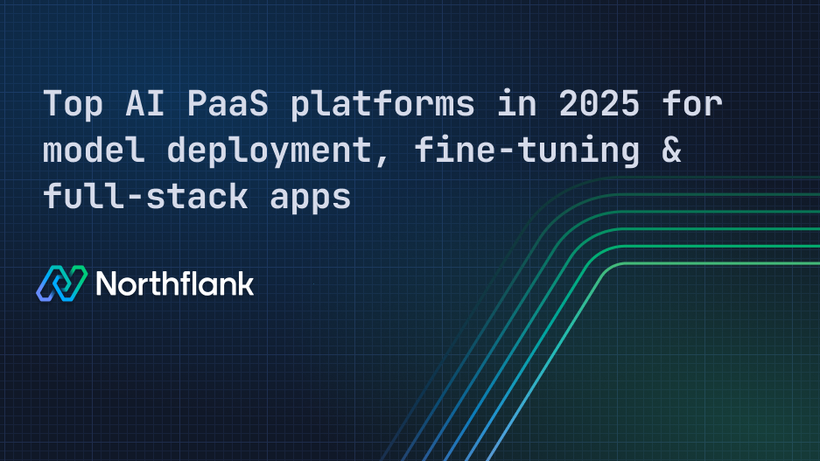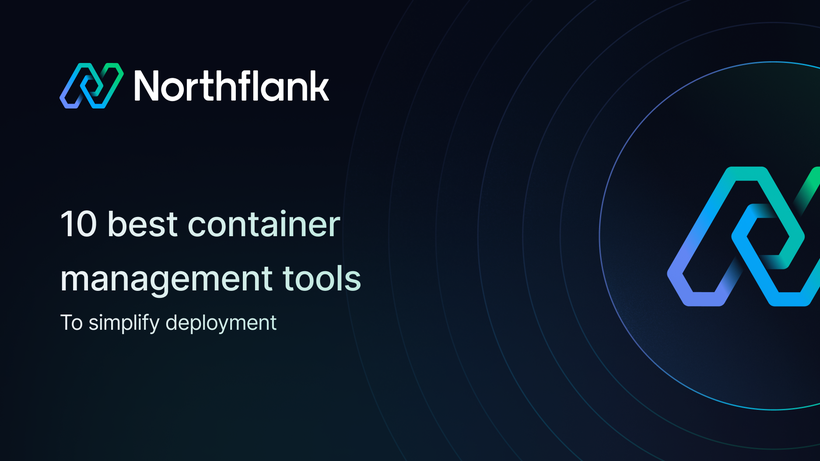

7 best Hugging Face alternatives in 2025: Model serving, fine-tuning & full-stack deployment
If you're looking for Hugging Face alternatives, maybe for:
- More control over how your models run in production
- Fine-tuning
- Deploying APIs
- Or building full-stack apps around them
I'll walk you through 7 platforms that help you do just that, while still letting you use the models you know and trust.
Okay, let's get into it.
If you're in a hurry, I've put together a quick list and summary of the 7 top alternatives to Hugging Face:
- Northflank – First on the list because it’s built for teams that want to run Hugging Face models with full control over infrastructure, fine-tune them, deploy APIs, and run supporting services like Postgres or Redis, all in one place.
- BentoML – Ideal for turning Hugging Face models into self-hosted REST APIs using Python. Lightweight and open-source, with a developer-friendly interface.
- Replicate – A hosted way to serve open-source models through inference APIs. Great for testing or integrating models quickly without setting up your own infrastructure.
- Modal – Useful for running Python functions or GPU jobs in the cloud. Fits well if you're focused on inference or fine-tuning through scheduled tasks.
- Lambda Labs – Provides raw access to GPUs with an SDK and CLI. You manage the environment and orchestration, but you get full control over resources.
- Together AI – Hosted APIs for open-source LLMs like LLaMA and Mixtral. Simple setup with usage-based pricing, good for building LLM features fast.
- RunPod – Lets you deploy containerized models on GPUs using pre-built templates. Lightweight option for quick inference tasks without managing full apps.
💡Make your choice based on how much control you need, what kind of workloads you're running, and how much infrastructure you want to manage.
However, if you're looking for a platform that handles model serving, fine-tuning, full app deployment, and secure multi-tenant environments, Northflank is your best choice.
Get started for free or book a demo to see for yourself.
Before I go into details for each of the alternatives to Hugging Face listed above, it's very important that you know what to look out for.
Because when you're thinking about where to run your models, it's not only about getting access to GPUs. You'll want a platform that can handle the way you build and ship things, particularly if you're working with fine-tuning, scheduling jobs, or deploying full apps around your models.
I'll list a few things you should keep in mind when comparing Hugging Face alternatives below:
-
GPU job orchestration
I know you're thinking, “Isn’t every platform doing this already?” Not really. Some tools only let you serve models. Others, like Northflank, let you schedule training jobs, fine-tune with PyTorch or DeepSpeed, and manage long-running GPU processes as part of your regular workflow. (See this in action)
-
Support for your tools
If you're already using things like Jupyter, PyTorch, DeepSpeed, or Ray, switching platforms shouldn’t break your setup. Northflank, for example, supports these out of the box, so you can run notebooks, distributed training jobs, or containerized workloads without changing your workflow.
-
Bring Your Own Cloud (BYOC)
Choosing where your GPU workloads run can help you save on cost and avoid being tied to a single provider. Some platforms offer their own GPU pool only. Others, like Northflank, let you bring GPUs from AWS, GCP, or custom providers and even mix spot and dedicated resources in hybrid setups. (See this in action)
-
Security for multi-tenant runtimes
If you're running anything that involves untrusted code, like your AI agents, notebooks, or sandboxed environments, then you need proper isolation. Platforms like Northflank that provide secure runtimes using microVMs and hardened container layers are a safer choice at scale.
You can read more on this in:
-
App-layer support
You’re likely deploying more than a model. That might include a Postgres database, a Redis cache, an API backend, background workers, or a CI/CD pipeline. Some platforms don’t account for this at all. Others like Northflank let you deploy the full stack in one place, including services your models depend on.
-
Fast provisioning and developer visibility
You want to spin things up quickly, scale smoothly, and still get access to logs and metrics when something breaks. Waiting 30 minutes for a GPU to be ready or struggling to trace errors through an unclear dashboard is time lost. On platforms like Northflank, provisioning usually takes under 30 minutes, and services come with built-in metrics and logs.
Not every platform gets it all right. However, if you're building more than a simple model endpoint, these are the things that will make or break your setup. If you need expert guidance or consultation to find the best platform that suits your company’s needs, book a 1:1 call with an expert here.
Now that you know what to look for, let’s walk through 7 Hugging Face alternatives that give you more control over how your models run, scale, and fit into your full stack.
Best for running Hugging Face models and your full application stack on your own infrastructure

Northflank isn’t a model hub. However, if you're pulling models from Hugging Face and want full control over how they run, this is where it stands out. You can:
- Serve, fine-tune, and deploy models like LLaMA, Mistral, and Whisper
- Treat GPU workloads like any other service (no special handling needed)
- Run APIs, databases, and background workers alongside your models
Northflank supports both GPU and non-GPU workloads in the same environment, so you can manage everything in one place.
It’s built for secure multi-tenancy, making it a good fit for AI agents, notebooks, and sandboxed code execution. For example:
- Cedana runs secure workloads with microVMs using Northflank (see full case study)
- Weights scaled to millions of users without a DevOps team (see full case study)
You can also bring your own cloud (BYOC). See what BYOC means.
It works with A100s, H100s, or spot GPUs across multiple providers using BYOC and hybrid cloud setups.
Also see: Top AI PaaS platforms
Go with this if you use Hugging Face for models, but want to run and scale them securely on your own infrastructure, with an all-in-one platform for fine-tuning, inference, background jobs, and full-stack services like databases, APIs, and CI/CD.
Get started with Northflank for free or book a demo. See pricing details.
Best for turning Hugging Face models into Python services

BentoML is an open-source tool that helps you package and serve machine learning models , including Hugging Face models, as Python APIs. It’s framework-agnostic, so you can work with PyTorch, TensorFlow, and Transformers without extra complexity. You can:
- Build and expose models as REST APIs using FastAPI
- Containerize everything with Docker
- Works well for local testing and cloud deployment
BentoML is a better fit for inference workloads than fine-tuning. It’s ideal if you're comfortable in Python and want to ship model services without managing too much infrastructure.
Go with this if you want to build and host Hugging Face models as REST APIs locally or on cloud infrastructure.
If you’re looking for alternatives to BentoML, see 6 best BentoML alternatives
Best for easy-to-use hosted inference endpoints

Replicate makes it easy to run Hugging Face models through a hosted API, with zero setup or infrastructure management required. You select a model (like Stable Diffusion, LLaMA, or Whisper), send a request, and get a result, including:
- Access trending open-source models through a simple API
- No need to deploy or manage containers
- Usage-based pricing tied to compute time
That simplicity comes with trade-offs. You don’t get much control over the underlying infrastructure, scaling behavior, or runtime limits.
Go with this if you want to plug in inference APIs without setting up infrastructure.
If you’re looking for alternatives to Replicate, see 6 best Replicate alternatives
Best for containerized GPU jobs and scheduled Python functions

Modal is a serverless platform built around running Python code on demand, which makes it a good fit for ML workloads that can be broken into jobs. You can:
- Run inference and fine-tuning jobs at scale
- Works with containers and Python functions
- Supports scheduling and job orchestration out of the box
What you don’t get is support for full-stack applications. There’s no built-in way to run persistent services, databases, or background workers outside of the job model.
Go with this if your workload is mostly Python-based GPU jobs.
If you’re looking for Modal alternatives, see 6 best Modal alternatives
Best for renting raw GPU compute

Lambda Labs gives you access to GPUs by the hour, with no opinionated runtime or deployment layer on top. It’s a good option if you want control over everything from the OS up. You can:
- Rent A100, H100, and other NVIDIA GPUs on demand
- Use the CLI or API to spin up instances
You don’t get built-in model serving, job scheduling, or full-stack support; it’s purely GPU infrastructure.
Go with this if you want direct GPU access and plan to build your own stack.
If you’re looking for Lambda AI alternatives, see Top Lambda AI alternatives
Best for hosted LLM inference using Hugging Face-compatible models

Together AI provides API access to open-source LLMs like LLaMA, Mistral, and Mixtral, many of which are also available on Hugging Face. You send a prompt, and get a response, without worrying about infrastructure. You get:
- Pay-per-token API pricing
- Access to popular Hugging Face-compatible LLMs
- Works well for embedding, summarization, and text generation
You won’t manage your own models, but it’s a fast way to integrate open models into your product.
Go with this if you need OpenAI-style API access to Hugging Face-hosted LLMs.
If you’re looking for alternatives to Together AI, see Top Together AI alternatives
Best for spinning up containers on GPU nodes

RunPod gives you a straightforward way to run containers on GPU-backed nodes. It’s more lightweight than a full platform, but works well if you only need compute with minimal overhead. You get:
- Prebuilt templates for Stable Diffusion, Whisper, and other Hugging Face-compatible models
- Bring your own container or use Jupyter, FastAPI, or Ollama templates
It’s a practical choice for quick experiments or serving models on demand, without the extras.
Go with this if you want GPU containers with minimal setup and don’t need a full-stack platform.
If you’re looking for RunPod alternatives, see RunPod alternatives
After going through the detailed breakdowns, I’ve put together a side-by-side comparison to help you choose the right alternative to Hugging Face based on your needs.
This table focuses on five core capabilities: fine-tuning, inference, full application support, BYOC (Bring Your Own Cloud), and secure runtime isolation.
| Platform | Fine-tuning support | Inference support | Full app support | BYOC available | Secure runtime isolation |
|---|---|---|---|---|---|
| Northflank | Built-in GPU jobs for fine-tuning | Supported with autoscaling | Run APIs, databases, workers together | Supported (run on your own cloud) | MicroVMs and hardened container isolation |
| BentoML | Limited support via framework add-ons | Convert models to REST APIs | Limited – mostly API-focused | Enterprise only | Basic container isolation only |
| Replicate | Limited (image models only via FLUX) | Hosted APIs for popular models | Not supported | Not supported | Not designed for untrusted workloads |
| Modal | Supports batch/scheduled fine-tuning | Works well for Python inference | No support for full-stack applications | Not supported | Limited isolation for containerized jobs |
| Lambda Labs | Pre-configured stack available; some manual scripting needed | Manual or bring your own stack | Not included in platform | Not supported | No built-in runtime isolation |
| Together AI | Supported (LoRA and full fine-tuning available via API) | Pay-per-token API access | Not supported | Not supported | Not built for secure multi-tenant execution |
| RunPod | Possible with setup | GPU containers with templates | No application-layer support | Limited BYOC depending on instance type | Basic sandboxing; no advanced isolation |
To wrap up, there’s no single drop-in replacement for Hugging Face. The right choice depends on what you’re building and how much control you need over your infrastructure and workflows. See a quick checklist:
- Do you want to self-host Hugging Face models, scale them across your own cloud, and run full applications securely? → Use Northflank
- Are you looking to package models as local APIs using FastAPI or Docker? → Use BentoML
- Do you need hosted inference with minimal setup? → Use Replicate or Together AI
- Do you prefer to rent raw GPU compute and build your own orchestration layer? → Use Lambda Labs or RunPod
Each of these tools supports different stages of the ML lifecycle, from serving to fine-tuning to surrounding app infrastructure. The choice comes down to how much of the stack you want to own and how much flexibility your workloads require.
If you’re looking for a single platform that handles inference, fine-tuning, background jobs, and full-stack app services on your own infrastructure, Northflank stands out.
You can get started for free or book a demo to see how it fits your stack.
I'll quickly address some of the questions developers often ask about Hugging Face and the tools you might use as alternatives.
-
What is the best alternative to Hugging Face?
If you still rely on Hugging Face for models but want more control over how they run, Northflank is the best alternative. For hosted inference APIs, Replicate or Together AI work well.
-
What are the top 5 alternatives to Hugging Face?
Top alternatives include:
- Northflank - to self-host models and run full applications across your own infrastructure
- BentoML - to package models as FastAPI or Docker-based APIs
- Replicate - to run inference with hosted model APIs
- Modal - to orchestrate GPU-backed Python functions and model jobs
- Lambda Labs - to rent raw GPU compute and bring your own orchestration setup
-
Why is Hugging Face so popular?
Hugging Face became popular for its Transformers library, which made it easy to access pretrained NLP models. It’s also widely used for its open model hub, datasets, and growing ecosystem around AI research and deployment.
-
Is Hugging Face better than OpenAI?
They serve different use cases. Hugging Face supports open-source models and community collaboration. OpenAI provides commercial APIs for proprietary models like GPT-4.
-
Is Hugging Face completely free?
Accessing models and datasets is free, but features like hosted inference endpoints or fine-tuning may require a paid plan, especially at scale.

